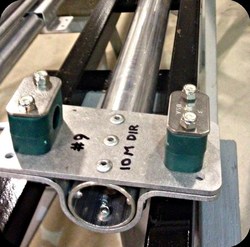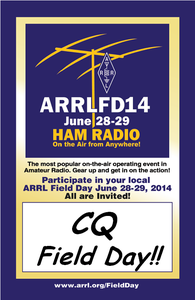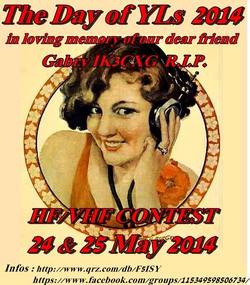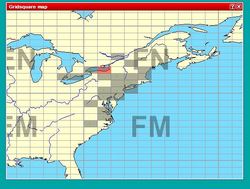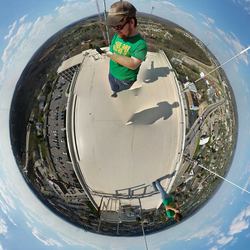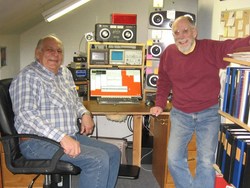 April 23, 2014 Editor: Ward Silver, NØAX | |||||||
IN THIS ISSUE
NEW HF OPERATORS - THINGS TO DO If you want to check a lot of states off your Worked All States list, don't miss the sixteen states that will be active in their regional or state QSO parties over the next couple of weekends. And you new to VHF+ operators - take a look at all the action going on above 10 meters! BULLETINS Did you submit your ARRL Rookie Roundup score? Make sure you do using the online submission form - the deadline is today! BUSTED QSOS No Easter eggs were found to have been hidden in the previous issue. CONTEST SUMMARY Complete information for all contests follows the Conversation section April 26-27
May 3-4
Contest University (CTU) is once again coming to the Dayton Hamvention, all day Thursday, May 15, with three full days of hamfesting fun to follow. If you like radio contesting, Contest University will help you become a better station builder and a better operator. CTU will have four classrooms of presentations running simultaneously, taught by eleven contest veterans, overloaded with helpful ideas to help you enjoy radio contesting more. The fun starts with breakfast at 7 AM and goes until 5 PM. Seating is limited, so be sure to register promptly if you want to be on the list of graduates this year! A full webinar on what's happening for contesters at Dayton is available online, too. (Thanks, CTU Chairman, Tim K3LR)
Owners of Force 12 antennas may be wondering, given that the company has just been sold to Innovantennas, will replacement parts be available. The answer is, "Certainly!" As the photo at right shows, not only are replacements available but in some cases, upgraded. (Thanks, Hector XE2K) How fast do we send anyway? Bob N6TV decided to use some new raw data archived by the Reverse Beacon Network, and found that the answer is: about 30 WPM. Bob analyzed data from both the 2013 CQ WW CW and the 2014 ARRL DX CW. Who's the fastest? The African stations like EF8U averaged 33-34 WPM on Saturday, then dialed it back a tad to about 33 WPM on Sunday. The rest of us are about 3 WPM slower.
Some light humor got involved in this product puffery, I think. (Thanks, Lynn N7CFO) Posters for Field Day 2014 are now available. These are two-sided 11x17 posters with a space for you to list your club's Field Day location and contact info. You can order them from the ARRL or download the PDF and print them yourself. The posters will also be available from the ARRL's Public Relations booth at the Dayton Hamvention. Web Site of the Week - Going to the Dayton Hamvention? The contesting action is hot and heavy at the Contest Supersuite. Here's the inside scoop from Tim, K3LR. WORD TO THE WISE Fuses - His reply when Gerald K5GW was asked what critical spare part is often forgotten on DXpeditions, "Fuses, more fuses." That might apply to the ham shack, too. I often tape a replacement fuse to an equipment enclosure or attach a plastic bag with replacements to a power distribution strip.
The World Wide Radio Operators Foundation (WWROF) is pleased to host Carl Luetzelschwab, K9LA, as he presents "Are We Headed Into Another Maunder Minimum? What Does That Mean for Propagation? Register in advance - the webinar is on April 24th at 9 PM EDT. Here's another great photo album from Hector XE2K with pictures from the recent Visalia, California International DX Convention. The full versions of the ARRL 160 Meter Contest and ARRL Phone Sweepstakes results have been published online. Special thanks are due to authors Gary K9AY and Steve N2IC for putting pen to paper (or fingers to keyboard) and keeping up the good work, year after year!
2013 Florida QSO Party results are online, too. DX logs were up 20% to a new record and logs from outside Florida were up a couple of percentage points, too. Overall, the log total is down 3% from 2012 but still above 1000. (Thanks, Chris WF3C) CQ World Wide Director, Randy K5ZD reports "There is a new blog entry on the CQ WW website that provides some additional information on error rates for CQ WW SSB 2013. The average error rate for all logs was 3.60%." Randy notes that "Percentages can be misleading. A station that makes 10 QSOs and has one error will have an error rate of 10%. There is no reason for anyone to feel bad at making a few errors in all the QRM of CQ WW SSB!" OPERATING TIP From K9JY's 30 Ham Radio Contesting Tips comes a good idea - if you are going to make a big effort in a contest, spend time in front of the radio one solar rotation before. The Sun rotates every 27 days and conditions are likely to be similar, although new sunspots can appear. There are lots of contests for you to use as for evaluating and estimating conditions. This weekend's events might be a good look ahead for the CQ WPX CW Contest on Memorial Day weekend.
Element sections getting stuck together are one thing but what about boom-sized pieces? Roger K8RI makes some suggestions about getting the pieces apart. "Clamp to each end of the boom. Hook one end to something solid and use a block and tackle or come-along off the other end to carefully pull the sections apart. The pull needs to be balanced so it pulls straight. There are many ways to clamp to the boom ends, such as using two [boom-to-mast] mounting plates each held with a pair of U-bolts...anything to allow a straight pull. The sections should easily pull apart although you might have to use some PB Blaster and let it soak...the clamps should not take much force. Just a cable loop anchored on opposite sides with the pull from the middle of the loop. Keep it simple and if it appears to look like it's going to take much force, stop and reevaluate. You might need to tap on opposite sides with rubber mallets to loosen things up. Do not use metal hammers. Apply hits to opposite sides at the same time. Do not hit hard. How do you grab on to large-diameter tubing, anyway? Steve K7LXC says "I've found that a chain wrench is real handy when dealing with round objects like booms and masts." Be careful not to let the chain bear on a corner or edge - that will create a permanent dimple.
I know my readers love their power tools so here's a new way to put your cordless drill to work in the kitchen - a power peeler! Bet you didn't know this! Mobile maven Alan KØBG notes, "Most automotive fuses are ATO. The difference is that the ATC (the C stands for 'closed') fuse element is completely sealed in plastic and the ATO (open) is not. Since [most radio] power cable fuse holders are not waterproof, only an ATC fuse should be used. If an ATO is used, and water gets into the fuse, the fuse element corrodes over time with predictable results." Technical Web Site of the Week - Tim K3HX sent a couple of good links to technical articles that may be of interest. The first is an EDN magazine article about measuring large currents - perhaps like we need to do in the bigger solid-state power amplifiers or in mobile installations. Another Electronic Design article explains the difference between watts and volt-amperes, a key specification of large transformers. We Can Handle It Regardless of where you stand on RM-11708, the proposed rule change to replace the U.S. HF band 300-baud symbol rate with a 2.8 kHz bandwidth limit -- pro, con, or indifferent -- you'll agree that it has generated a lot of discussion. Unfortunately, like many discussions in the Internet Age, the tenor has often become pointed and personal. Similarly, speculation gets repeated and amplified until it takes on the status of facts. We have two obligations to ourselves and the amateur service - to tone it down and to stop gossiping. Reading some of the comments, I doubt that the writers would say in person what they say from a distant keyboard. Enough with the ad hominem attacks - I don't know anyone on either side of the issue who I suspect of working to actively undermine ham radio. Try to disagree without being disagreeable. Show some respect (and class) in our communications. On the second issue - gossip - as licensed amateurs it is incumbent on each of us to perform due diligence by actually reading and evaluating the regulations and technical issues involved. Instead of blindly copying and pasting whatever happens to stroke our particular inclinations, take the time to become educated. You will find that technical issues are rarely black-and-white, either-or propositions. From similar episodes in ham radio's past, we should know that hypothetical apocalypses and conspiracies are just that - imaginary. In the absence of information, resist the temptation to jump to conclusions. Realize that "could" is not the same as "will." Personal attacks and unqualified speculation do our image and credibility no favors at the FCC, the ITU, or in professional circles. It is likely that in the coming years the amateur service will experience an entire series of regulatory and organizational transitions. Technology is changing. The demographics of hams are changing. The ways in which we operate and interact and create value in Amateur Radio are changing. We're going to have to work together in good faith to devise and implement workable plans. In order to fulfill our Basis and Purpose, it's necessary for each of us to act responsibly. There have been many difficult decisions and changes in our past 100 years, yet we have worked out the bugs and celebrated the features, creating a pretty amazing and broad amateur service. Which reminds me - we are Amateur Radio Operators, for crying out loud - inventors and users of the planet-wide non-government, non-commercial communications system! I don't think for a minute, no matter what a single decision on baud or bandwidth turns out to be, we can't make it work. There will be technological solutions, regulatory solutions, and social solutions. We can handle it. April 23 through May 6 An expanded, downloadable version of QST's Contest Corral in PDF format is available. Check the sponsor's Web site for information on operating time restrictions and other instructions. HF CONTESTS Ten-Ten Spring Digital Contest--Digital, from Apr 26, 0001Z to Apr 27, 2359Z. Bands (MHz): 28. Exchange: Call, name, county & S/P/C, 10-10 number. Logs due: 15 days. Rules SP DX RTTY Contest--Digital, from Apr 26, 1200Z to Apr 27, 1200Z . Bands (MHz): 3.5-28. Exchange: RST, serial, SP province. Logs due: May 5. Rules Helvetia Contest--Phone,CW,Digital, from Apr 26, 1300Z to Apr 27, 1259Z . Bands (MHz): 1.8-28. Exchange: RS(T), serial or Swiss canton. Logs due: 15 days. Rules Florida QSO Party--Phone,CW, from Apr 26, 1600Z - See website. Multiple time periods. Bands (MHz): 7-28. See website. Exchange: RS(T), FL county or S/P/C. Logs due: 30 days. Rules BARTG 75 Sprint--Digital, from Apr 27, 1700Z to Apr 27, 2100Z. Bands (MHz): 3.5-28. Exchange: Serial. Logs due: Jun 1. Rules NS Weekly Sprint--CW, from May 2, 0230Z to May 2, 0300Z. Bands (MHz): 1.8-14. Weekly on Thursday evenings local time. Exchange: Serial, name, and S/P/C. Logs due: 2 days. Rules Ten-Ten Spring CW Contest--CW, from May 3, 0001Z to May 4, 2359Z. Bands (MHz): 28. Exchange: Call sign, name, 10-10 number, state. Logs due: 15 days. Rules QRP To The Field--CW, from May 3, 1200Z to May 3, 2359Z. Bands (MHz): 7-28. Exchange: RST, S/P/C. Logs due: Jun 1. Rules ARI International DX Contest--Phone,CW,Digital, from May 3, 1200Z to May 4, 1159Z. Bands (MHz): 1.8-28. Exchange: RS(T), serial or Italian province. Logs due: 5 days. Rules 7th Area QSO Party--Phone,CW,Digital, from May 3, 1300Z to May 4, 0700Z. Bands (MHz): 1.8-28, 50,144, CW--40 kHz above band edge; SSB--1.845, 3.855, 7.235, 14.255, 21.355, 28.455 MHz. Exchange: RS(T)+S/P or 7th-area county code. Logs due: Jun 2. Rules Indiana QSO Party--Phone,CW, from May 3, 1600Z to May 4, 0400Z. Bands (MHz): 1.8-28. CW--1.805 and 40 kHz above the band edge on 80-10 meters, SSB--1.845, 3.820, 7.190, 14.250, 21.300, 28.400 MHz. Exchange: RS(T) + S/P or IN county, DX RS(T) only. Logs due: Jun 15. Rules Radio Club of America QSO Party--Phone, from May 3, 1700Z to May 4, 0459Z. Bands (MHz): 3.5-21. Exchange: RS, QTH, name, equipment. Rules New England QSO Party--Phone,CW,Digital, from May 3, 2000Z - See website. Multiple time periods. Bands (MHz): 3.5-28. CW--3.540, 7.035, 14.040, 21.040, 28.040; SSB--3.850, 7.180/280, 14.280, 21.380, 28.380 MHz. Exchange: RS(T) and S/P or New England county. Logs due: 30 days. Rules OK1WC Memorial Contest--Phone,CW, from May 5, 1630Z - See website. Multiple time periods. Bands (MHz): 3.5, 7. Weekly on Monday, see website for bands. Exchange: RS(T) and serial. Logs due: 5 days. Rules ARS Spartan Sprint--CW, from May 6, 0200Z to May 6, 0400Z. Bands (MHz): 3.5-28. Monthly on the first Monday evening local time. Exchange: RST, S/P/C, and power. Logs due: 2 days. Rules VHF+ CONTESTS VHF Spring Sprints--Phone,CW,Digital, from Apr 23, 7 PM to Apr 23, 11 PM. Bands (MHz): 432. Exchange: Grid square (6-character preferred). Logs due: 14 days. Rules 2 GHz and Up World Wide Contest--Phone,CW,Digital, from May 3, 6 AM to May 4, Midnight. Bands (MHz): 2.3G+. Exchange: 6-char grid locator. Logs due: 30 days. Rules Microwave Spring Sprint--Phone,CW,Digital, from May 3, 6 AM to May 3, 1 PM. Bands (MHz): 902+. Exchange: Grid square (6-character preferred). Logs due: 14 days. Rules Worldwide EME Contest--Phone,CW, from May 3, 0000Z to May 4, 2400Z. Bands (MHz): 3.4G. Exchange: TMO/RS(T) and "R". Logs due: Jun 15. Rules 7th Area QSO Party--Phone,CW,Digital, from May 3, 1300Z to May 4, 0700Z. Bands (MHz): 1.8-28, 50,144, CW--40 kHz above band edge; SSB--1.845, 3.855, 7.235, 14.255, 21.355, 28.455 MHz. Exchange: RS(T)+S/P or 7th-area county code. Logs due: Jun 2. Rules LOG DUE DATES 23 April through 6 May
ARRL Information Click here to advertise in this newsletter, space subject to availability. Your One-Stop Resource for Amateur Radio News and Information ARRL membership includes QST, Amateur Radio's most popular and informative journal, delivered to your mailbox each month. Subscribe to NCJ - the National Contest Journal. Published bimonthly, features articles by top contesters, letters, hints, statistics, scores, NA Sprint and QSO Parties. Subscribe to QEX - A Forum for Communications Experimenters. Published bimonthly, features technical articles, construction projects, columns and other items of interest to radio amateurs and communications professionals. Free of charge to ARRL members: Subscribe to The ARRL Letter (weekly digest of news and information), the ARES E-Letter (monthly public service and emergency communications news), Division and Section news -- and much more! ARRL offers a wide array of products to enhance your enjoyment of Amateur Radio. Visit the site often for new publications, specials and sales. Donate to the fund of your choice -- support programs not funded by member dues! Reprint permission can be obtained by sending email to permission@arrl.org with a description of the material and the reprint publication. ACKNOWLEDGEMENTS ARRL Contest Update wishes to acknowledge information from WA7BNM's Contest Calendar and SM3CER's Contest Calendar. | |||||||
